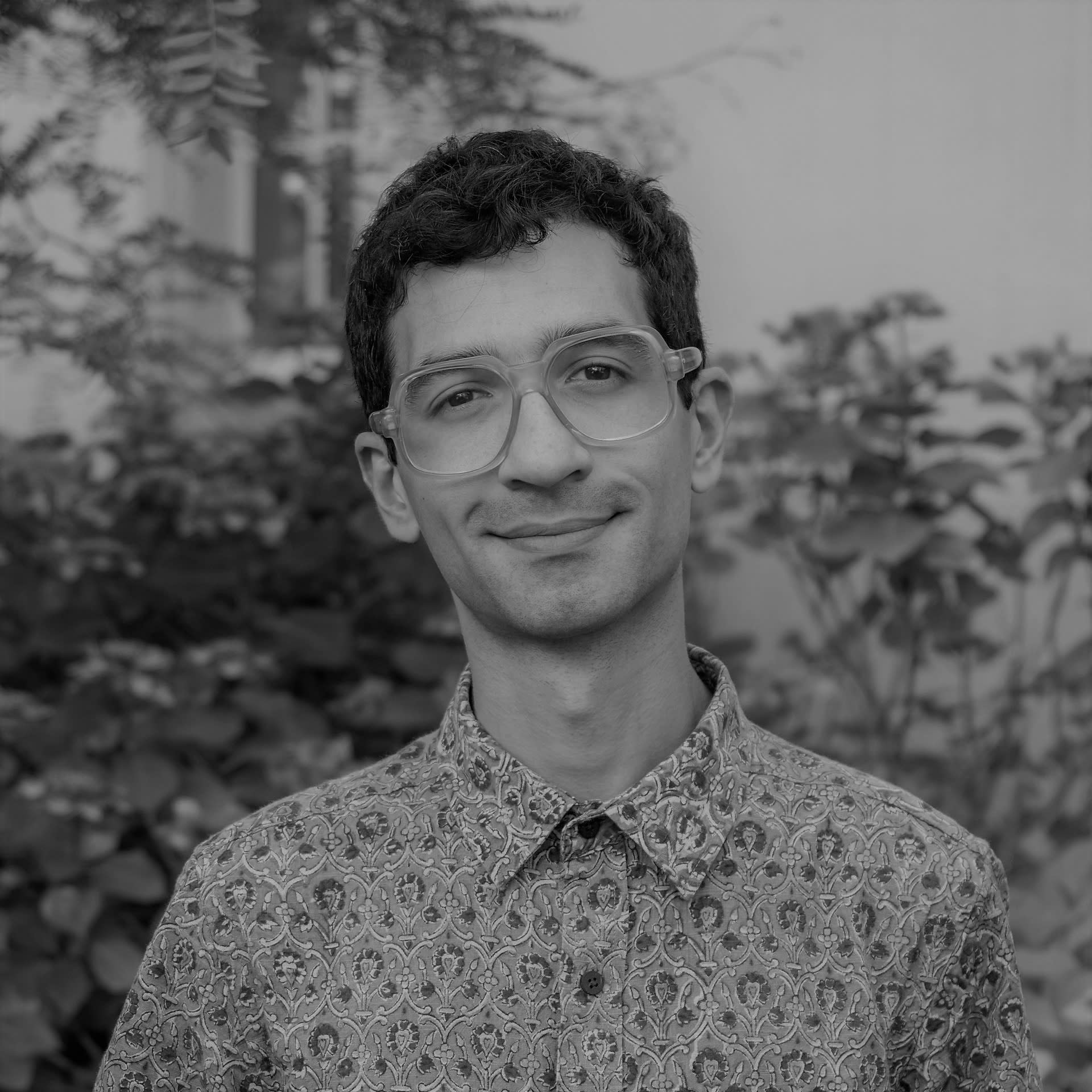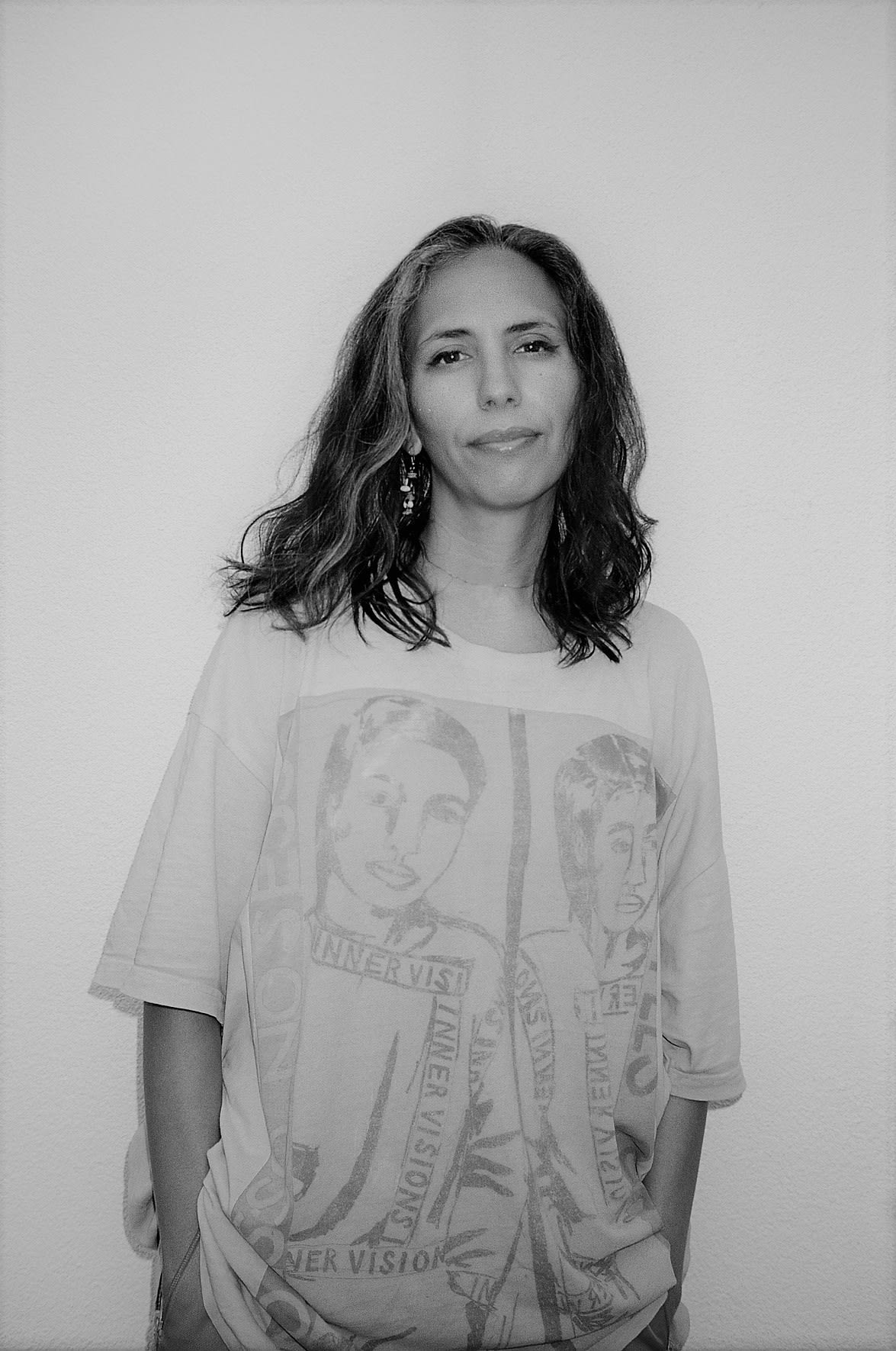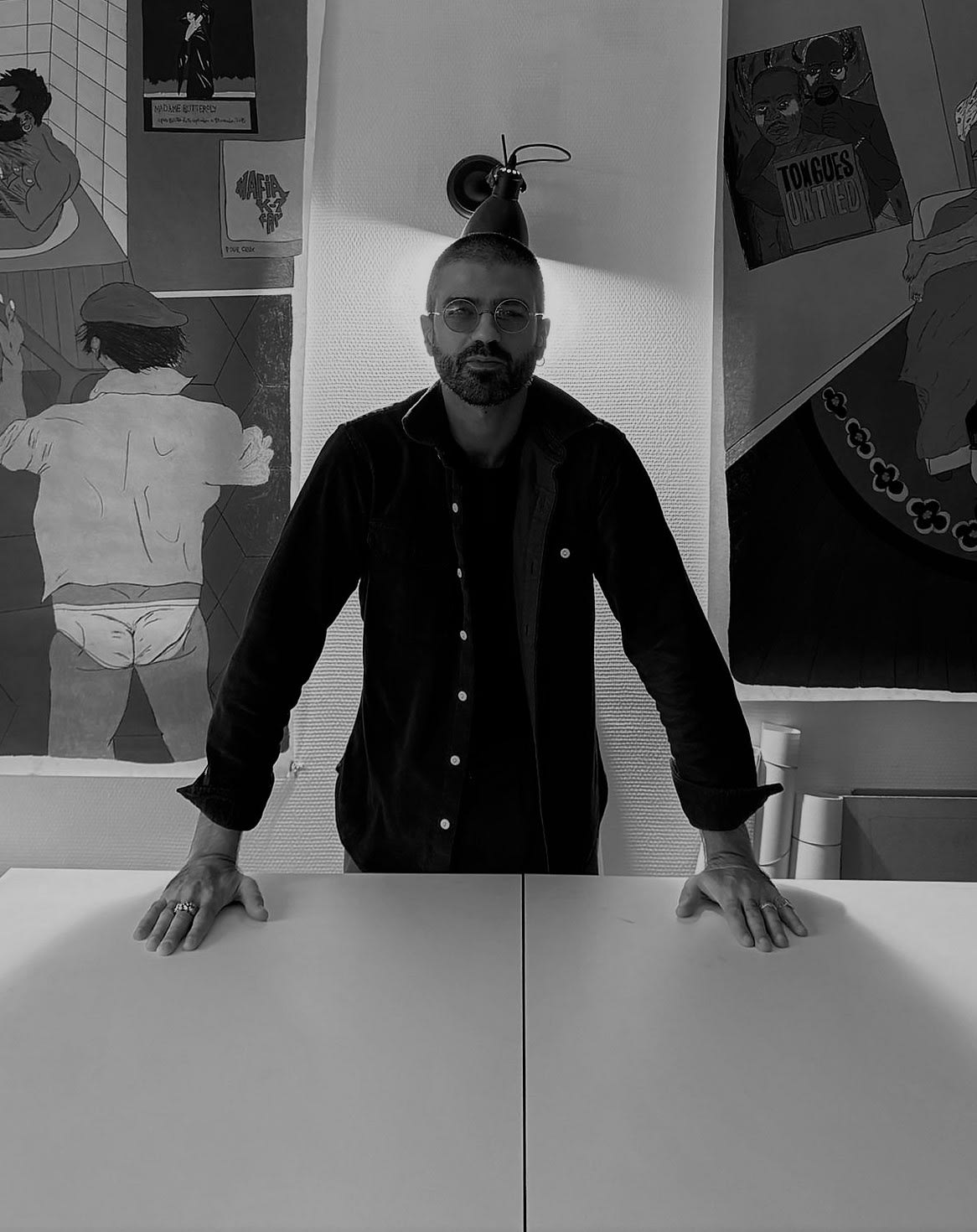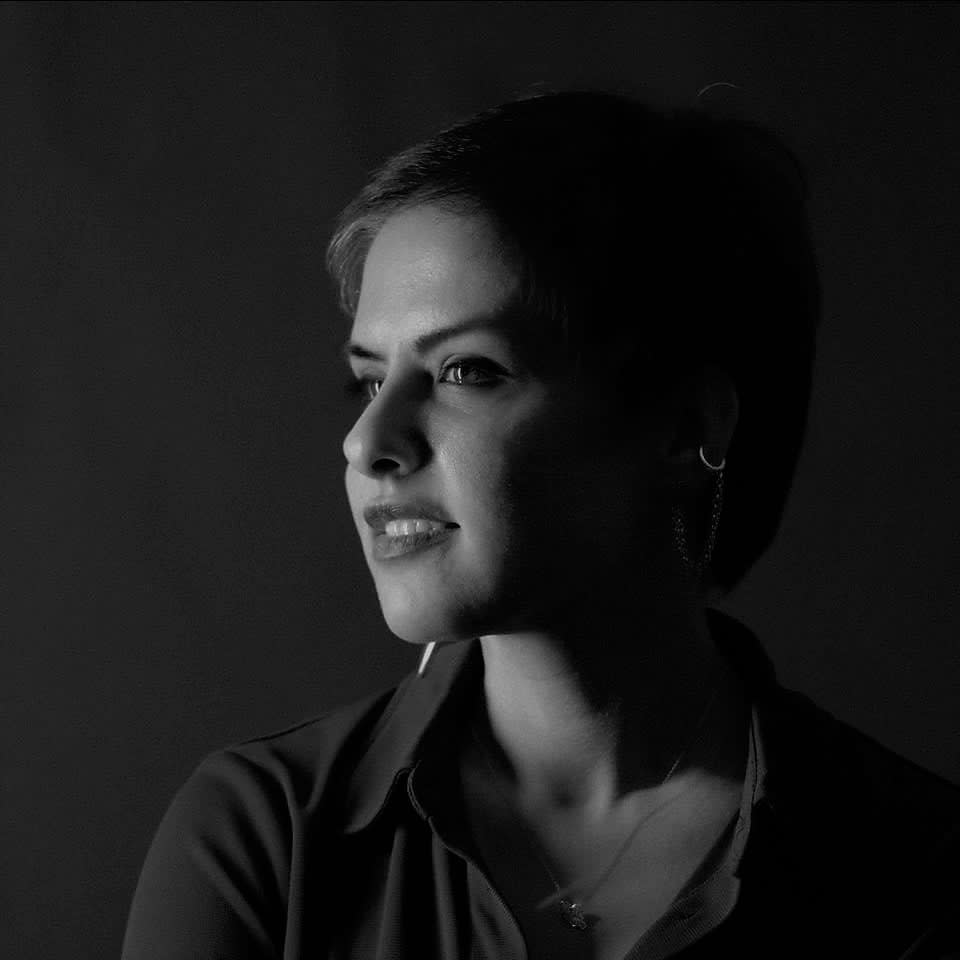-
Neither Here ~ Nor Elsewhere
Sanaz Askari
-
Neither Here ~ Nor Elsewher
Sanaz Askari
Neither Here ~ Nor Elsewhere, is a group exhibition curated by Sanaz Askari, bringing together a diverse collective of artists from across Africa and Asia. Selected artists include Faissal El Malak, Hayv Kahraman, Mahsa Merci, Michael Ho, Omar Mismar, Sam Samiee, Sophia Al-Maria, Soufiane Ababri, Tahmineh Monzavi, and Yumna Al-Arashi, all of whom convey narratives of identity, desire, displacement, and resistance in response to prevailing cultural and political conditions shaped by migration, censorship, and societal marginalisation.
The exhibition centres on the tension between fear and fantasy, the public and the private, as experienced by marginalised bodies existing within distinct socio-political frameworks. The artists challenge social hierarchies and restrictions that limit the spaces they inhabit, pushing back against the forces that constrain their identities while revealing inner desires, embracing fluidity, and exploring the fragmentation of preconceived settings. Through a reimagining of the corporeal in relation to its surroundings, their explorations reveal transformative possibilities for existence.
The works span a range of disciplines, including photography, video art, and works on paper and canvas, exploring mechanisms of control—such as social norms, gender standards, and moral codes—highlighting their pervasive influence and questioning their legitimacy.
Faissal El-Malak creates playful, fantasy-like folkloric imagery and paintings that reference themes of identity and displacement, reflecting on the intersections of personal and collective histories often overlooked or suppressed. Juxtaposing exile with generational trauma, his work emerges from a surreal dream of lizards dancing. Through this imagery, he examines the enduring psychological impact of displacement.
Hayv Kahraman confronts the fragility of, and trauma imposed on, the gendered body while also asserting its power.
Mahsa Merci positions the politicised body as a form of expression, transgression, and liberation. She paints her friends with their backs turned to the viewer, concealing their identities while highlighting their multifaceted personas in public spaces. The number 3, tattooed on the back of her subject, symbolizes the three personas her character embodies, each hidden from the others.
Michael Ho’s film hints at Chinese authority’s control, using the karaoke room as a communal safe space for discussing the forbidden and the profane.
Omar Mismar draws on personal experience, social anxieties, and his search for intimacy in The Path of Love, a neon installation that engages themes of belonging and marginalisation in the digital realm, particularly on apps, where the potential for connection is amplified and complicated.
Sam Samiee’s portraits challenge the hegemony of Western figuration by harnessing agency to depict young men from Eastern Islamicate nations in intimate, staged moments. Drawing on the calligraphic style of Nastaliq, the series reclaims the beauty and complexity of male figures beyond Western standards, confronting distorted historical narratives and inviting a fresh, humanising gaze.
Sophia Al-Maria engages with science fiction and speculative storytelling, envisioning chaos and destruction fueled by sensual energy. Her work presents the end of the world as a love story, emphasising humanity’s futility in the cosmos.
Soufiane Ababri draws attention to everyday life in the streets of Paris or his other home in Tangier, examining the nuanced and layered experience of dual marginalisation in both places. Through his intimate and vulnerable depictions, he explores the intersections of race, intimacy, and identity, capturing the quiet resistance of those who navigate spaces where they are both hyper-visible and invisible. Ababri’s work often challenges societal stereotypes and power structures, presenting moments of tenderness and strength that redefine what it means to exist on the margins.
Tahmineh Monzavi reflects on alienation, misogyny, the historical suppression of women, and the taboos that seek to constrain and shame women’s bodies. In her video OXYS—a reference to oxytocin (the "love hormone")—she contemplates the metaphor of a woman’s body as pregnant, incubating love as a way to cope with the solitude of imprisonment, even though she is not physically pregnant.
Yumna Al-Arashi explores fragmented female bodies, presenting them as sites of vulnerability and strength, while challenging societal perceptions of femininity and identity.
In this group exhibition, fantasy becomes an emancipatory force—a gateway for coping, dismantling traditional power structures, and allowing bodies to spiral freely into realms of otherness. Fantasy becomes a tool for both critique and healing, allowing for the subversion of oppressive realities and the exploration of alternative modes of existence, venturing into dreamlike landscapes of liberation and imagination.
-
-

-
-

-
-
 Hayv Kahraman, Tentacular eye boobs, 2023, Oil and Torshi on Linen, 127.00 x 127.00 x 4 cm
Hayv Kahraman, Tentacular eye boobs, 2023, Oil and Torshi on Linen, 127.00 x 127.00 x 4 cm -
 Hayv Kahraman, Composite figure drawing, 2023, Ink, dried pigment, flax fibers on paper, 21.30 x 21.30 cm
Hayv Kahraman, Composite figure drawing, 2023, Ink, dried pigment, flax fibers on paper, 21.30 x 21.30 cm -
 Hayv Kahraman, Torshi eye boobs drawing, 2023, Ink, Dried Pigment, Flax Fibers on Paper, 21.30 x 21.30 cm
Hayv Kahraman, Torshi eye boobs drawing, 2023, Ink, Dried Pigment, Flax Fibers on Paper, 21.30 x 21.30 cm
-
-
-

-
-

-
-

-
-
About Sam Samiee

Sam Samiee (b. 1988, Tehran) is a multidisciplinary Iranian-Dutch artist, painter, essayist, and researcher whose work spans painting, installation, and curatorial practice. Rooted in both the history of European painting and Persianate cultural traditions, he creates works that bridge cultures, drawing on a range of art historical references and personal experiences. His practice intersects painting, psychoanalysis, and cultural history, demonstrating a conceptual engagement with both Western and non-Western art traditions.
Samiee received his artistic training at the University of Art in Tehran, further developing his practice at AKI ArtEZ in the Netherlands and the Rijksakademie van beeldende kunsten in Amsterdam. His technical mastery reflects a deep engagement with historical and contemporary techniques, emphasizing the foundational importance of drawing as a method of structuring and rationalizing painting. His work is known for its vibrant and expressive use of color, dynamic brushwork, and layered textures, engaging viewers on both sensory and intellectual levels.
His work often engages with psychoanalysis, literature, and the complexities of cultural memory. Exhibitions explore complex relationships between cultural, historical, and philosophical narratives, incorporating elements from Persianate traditions and contemporary European discourse. Samiee's artworks invite active sensory and intellectual engagement, emphasizing the "here-and-now" experience where the viewer plays a crucial role in reconstructing meaning, making the narrative fluid and ever-evolving.
Samiee's work has been featured in prestigious settings such as the 10th Berlin Biennale, Kunstmuseum Den Haag, Manchester Art Gallery, and Parasol Unit in London, as well as prominent art fairs like Art Basel Hong Kong and Liste Art Fair Basel. His pieces are part of collections at notable institutions like the Taylors Museum, Centraal Museum in Utrecht, and the Kadist Art Foundation.
He is a recipient of the Royal Dutch Painting Prize and the Wolvecamp Prize, both of which he has also served as a jury member. His curatorial projects, notably Farideh Lashai: Afloat Over Undulations in Abu Dhabi (2022), reflect his interest in expanding dialogues between painting, literature, and digital media.
-
About Sophia Al-Maria

Sophia Al-Maria is an artist, author and filmmaker. She grew up between the United States, the Emirates and Qatar before moving to Egypt to study comparative literature at the American University in Cairo. She earned an MA in aural and visual cultures at Goldsmiths, London before returning to Qatar to work at Mathaf: the Arab Museum of Modern Art. She is currently based in London where she works in art, film and TV. The seemingly disparate sources of inspiration for Al Maria’s multidisciplinary practice include pop culture, pre-Islamic Arabic poetry and science-fiction. Working primarily with film and narrative text, Al-Maria weaves captivating speculative fictions through her video and collage work. Her videos often focus on the isolation of individuals via technology, consumerism as proxy religion, and how agency and chance play in the blinding approach of an uncertain future.
Her work has been shown in various international exhibitions including but not limited to: Grey Unpleasant Land with Lydia Ourahmane, Spike Island, Bristol (2024); Not My Bag, Henry Art Gallery, Seattle, USA (2023); Invisible Labors daydream therapy, Mathaf, Arab Museum of Modern Art, Doha, Qatar (2022); Beast Type Song, GARAGE, Moscow (2021); taraxos, Serpentine x Modern Forms Sculpture Commission, London (2021); Bitch Omega, Julia Stoschek, Dusseldorf, Germany (2020); Beast Type Song, Tate Britain, London, UK (2019); Project Room #10, Sophia Al-Maria, Mirror Cookie, Fondazione Pomodoro, Milan, Italy (2019); Sophia Al-Maria: BCE, Whitechapel Gallery, London, UK (2019); Sophia Al Maria: Black Friday, Mercer Union, Images Festival, Toronto, Canada (2018);Biennale of Moving Images, Miami, USA (2017); Axis Mundi, High Line Art, New York, USA (2017); No to the Invasion: Breakdowns and Side Effect, CCS Bard Gallery, NY, USA (2017); Mondialite, Villa Empain Boghossian Foundation, Brussels, Belgium (2017).
Her work is featured in various international collections including Whitney Museum of American Art, New York, USA, Museum of Contemporary Art, Chicago, USA, Art Jameel, Dubai, UAE, MATHAF, Doha, Qatar, Barjeel Art Foundation, Sharjah, UAE, Julia Stoschek Foundation, Berlin, Germany, LUMA Foundation, Arles, France, TATE, London, UK, PCAI Collection, Athens, Greece and Los Angeles County Museum of Art, California, USA.
-
-
About Soufiane Ababri

Soufiane Ababri’s (b.1985, Rabat, Morocco) visual storytelling is akin to an art-historical activism questioning the process of history writing while emphasizing minor histories and intimate recorded events as the point of departure of his works. Deftly weaving his own biography and heritage with the intellectual and artistic output of figures such as Jean Genet, Michel Foucault, Felix Gonzales Torres, Allen Ginsberg or Nazim Hikmet, his works mobilize the anecdotal, diaristic and sometimes accidental as the location where an intimate knowledge based on affinities can engender a sense of community in motion across time and place. Besides series of drawings and collages on paper, Ababri actively engages with installation, sculpture and performance to create immersive environments in reference to clandestine forms of socializing, acting through theatricality to reflect on how we record, share, claim and participate in collective resonances of our most intimate fantasies and fears.
Ababri has had solo exhibitions worldwide including: Their mouths were full of bumblebees but it was me who was pollinated, The Curve, Barbican, London, UK (2024); Si nous ne brûlons pas, comment éclairer la nuit?, Praz-Delavallade, Paris (2023); NON MERCII!!!, Dittrich & Schlechtriem, Berlin (2022); Bunch of Queequeg, Praz-Delavallade, Los Angeles (2021); YES! AÏ AÏ AÏ AÏ AÏ AÏ AÏ ... AM, Mendes Wood DM, Brussels (2021); A Circus Act Behind Bars of Lilac And Blood, Kulte Art Center, Rabat (2020); Tropical Concrete Gym Park, Glassbox, Paris (2020); Memories Of A Solitary Cruise, THE PILL® Istanbul (2019).
His work has been shown in institutional group shows such as Every Moment Counts, Henie Onstad Kunstsenter Oslo, (2022); Queering The Narrative, Neuer Aachener Kunstverein, Aachen (2022); Trilogie des cendres, FRAC Pays de la Loire, Carquefou, (2022); Habibi, les révolutions de l’amour, Institute du Monde Arabe, Paris, (2022); Attention, International Festival For Contemporary Art Glasgow (2021); Welcome Home Vol.II, MACAAL Marrakesh (2020); Lignes de vies - Une exposition de légendes, MAC VAL Vitry, (2019) and Par amour du jeu, Magasins Généraux Pantin (2018), among others.
His work is part of private and public collections of FRAC Poitou-Charentes and FRAC Pays de la Loire; MACVAL; Museum of African Contemporary Art Al Maaden in Morocco and X Museum in Beijing.
-
-
 Soufiane Ababri, Bedwork 1, 2017-2022, Coloured pencils on paper, 32 x 24 cm, Courtesy of the artist and THE PILL®
Soufiane Ababri, Bedwork 1, 2017-2022, Coloured pencils on paper, 32 x 24 cm, Courtesy of the artist and THE PILL® -
 Soufiane Ababri, Bedwork 2, 2017-2022, Coloured pencils on paper, 32 x 24 cm, Courtesy of the artist and THE PILL®
Soufiane Ababri, Bedwork 2, 2017-2022, Coloured pencils on paper, 32 x 24 cm, Courtesy of the artist and THE PILL® -
 Soufiane Ababri, Bedwork 3, 2017-2022, Coloured pencils on paper, 32 x 24 cm, Courtesy of the artist and THE PILL®
Soufiane Ababri, Bedwork 3, 2017-2022, Coloured pencils on paper, 32 x 24 cm, Courtesy of the artist and THE PILL® -
 Soufiane Ababri, Bedwork 4, 2017-2022, Coloured pencils on paper, 32 x 24 cm, Courtesy of the artist and THE PILL®
Soufiane Ababri, Bedwork 4, 2017-2022, Coloured pencils on paper, 32 x 24 cm, Courtesy of the artist and THE PILL® -
 Soufiane Ababri, Bedwork 5, 2017-2022, Coloured pencils on paper, 32 x 24 cm, Courtesy of the artist and THE PILL®
Soufiane Ababri, Bedwork 5, 2017-2022, Coloured pencils on paper, 32 x 24 cm, Courtesy of the artist and THE PILL® -
 Soufiane Ababri, Bedwork 6, 2017-2022, Coloured pencils on paper, 32 x 24 cm, Courtesy of the artist and THE PILL®
Soufiane Ababri, Bedwork 6, 2017-2022, Coloured pencils on paper, 32 x 24 cm, Courtesy of the artist and THE PILL® -
 Soufiane Ababri, Bedwork 7, 2017-2022, Coloured pencils on paper, 32 x 24 cm, Courtesy of the artist and THE PILL®
Soufiane Ababri, Bedwork 7, 2017-2022, Coloured pencils on paper, 32 x 24 cm, Courtesy of the artist and THE PILL® -
 Soufiane Ababri, Bedwork 8, 2017-2022, Coloured pencils on paper, 32 x 24 cm, Courtesy of the artist and THE PILL®
Soufiane Ababri, Bedwork 8, 2017-2022, Coloured pencils on paper, 32 x 24 cm, Courtesy of the artist and THE PILL® -
 Soufiane Ababri, Bedwork 9, 2017-2022, Coloured pencils on paper, 32 x 24 cm, Courtesy of the artist and THE PILL®
Soufiane Ababri, Bedwork 9, 2017-2022, Coloured pencils on paper, 32 x 24 cm, Courtesy of the artist and THE PILL® -
 Soufiane Ababri, Bedwork 10, 2017-2022, Coloured pencils on paper, 32 x 24 cm, Courtesy of the artist and THE PILL®
Soufiane Ababri, Bedwork 10, 2017-2022, Coloured pencils on paper, 32 x 24 cm, Courtesy of the artist and THE PILL® -
 Soufiane Ababri, Bedwork 11, 2017-2022, Coloured pencils on paper, 32 x 24 cm, Courtesy of the artist and THE PILL®
Soufiane Ababri, Bedwork 11, 2017-2022, Coloured pencils on paper, 32 x 24 cm, Courtesy of the artist and THE PILL® -
 Soufiane Ababri, Bedwork 12, 2017-2022, Coloured pencils on paper, 32 x 24 cm, Courtesy of the artist and THE PILL®
Soufiane Ababri, Bedwork 12, 2017-2022, Coloured pencils on paper, 32 x 24 cm, Courtesy of the artist and THE PILL® -
 Soufiane Ababri, Bedwork 13, 2017-2022, Coloured pencils on paper, 32 x 24 cm, Courtesy of the artist and THE PILL®
Soufiane Ababri, Bedwork 13, 2017-2022, Coloured pencils on paper, 32 x 24 cm, Courtesy of the artist and THE PILL® -
 Soufiane Ababri, Bedwork 14, 2017-2022, Coloured pencils on paper, 32 x 24 cm, Courtesy of the artist and THE PILL®
Soufiane Ababri, Bedwork 14, 2017-2022, Coloured pencils on paper, 32 x 24 cm, Courtesy of the artist and THE PILL® -
 Soufiane Ababri, Bedwork 15, 2017-2022, Coloured pencils on paper, 32 x 24 cm, Courtesy of the artist and THE PILL®
Soufiane Ababri, Bedwork 15, 2017-2022, Coloured pencils on paper, 32 x 24 cm, Courtesy of the artist and THE PILL® -
 Soufiane Ababri, Bedwork 16, 2017-2022, Coloured pencils on paper, 32 x 24 cm, Courtesy of the artist and THE PILL®
Soufiane Ababri, Bedwork 16, 2017-2022, Coloured pencils on paper, 32 x 24 cm, Courtesy of the artist and THE PILL® -
 Soufiane Ababri, Bedwork 17, 2017-2022, Coloured pencils on paper, 32 x 24 cm, Courtesy of the artist and THE PILL®
Soufiane Ababri, Bedwork 17, 2017-2022, Coloured pencils on paper, 32 x 24 cm, Courtesy of the artist and THE PILL® -
 Soufiane Ababri, Bedwork 18, 2017-2022, Coloured pencils on paper, 32 x 24 cm, Courtesy of the artist and THE PILL®
Soufiane Ababri, Bedwork 18, 2017-2022, Coloured pencils on paper, 32 x 24 cm, Courtesy of the artist and THE PILL®
-
-
-
About Tahmineh Monzavi

Tahmineh Monzavi (b. 1988, Iran) is a photographer, video artist, documentary filmmaker and producer, who lives and works in Tehran. She began her professional career in 2005, finding inspiration in the social issues that impact women, marginalized populations and oppressed communities, but also in the neglected environment and the fragile cultural patrimony of her native Iran and neighboring Afghanistan.
In 2012, at 23, Monzavi was arrested by Iranian security forces. Her sentence: 30 days in solitary confinement in the notorious Evin Prison, followed by 90 days house arrest. The strain of that cruel and absurd punishment caused her great harm, resulting in Monzavi losing her hair permanently, a visible scar she still carries today Monzavi’s outlook on her work was changed after a month of imprisonment. In the absence of human contact, she started to doubt her existence. In that dark hour of forced isolation Tahmineh was desperate for a company and started to fantasize being pregnant, which resulted in the video art piece OXYS in black and white.
Fearless and unabated, Monzavi continues to focus her lens on the downtrodden in Iran, finding beauty and poetry in her country’s vibrant underground culture, in the working-class neighborhoods of old Tehran, in the lifestyles of nomadic populations, in her homeland’s natural vistas and majestic architectural ruins, and in the crumbling cultural heritage of a war-riddled Afghanistan. Her works have been exhibited nationally and internationally: Los Angeles County Museum of Art (LACMA), MAXXI museum of Roma, Musée d'Art Moderne de la Ville de Paris and many others.
Monzavi is also known as a film director and producer. Sometimes her photography and film work merge into continuous subject of artistic exploration. For example, the Grape garden alley series in 2010-2012 developed into a feature length documentary film about a shelter for addicted women in Tehran. As a co-director. She had an important interview in this film with Jean Cloud Carrier. Tahmineh received international recognition with the film About the Salesman (2018), A film about a film which won two trophies for the Best Actor and Best Screenplay at the Cannes Film Festival in 2016 and the Academy Award for Best Foreign Language Film in 2017.
-
-

-
-
 Yumna Al-Arashi, Everything In Its Right Place I, 2024, Collaged C-Type Print, 42 x 29.70 cm, Edition of 2, 1 AP
Yumna Al-Arashi, Everything In Its Right Place I, 2024, Collaged C-Type Print, 42 x 29.70 cm, Edition of 2, 1 AP -
 Yumna Al-Arashi, Everything In Its Right Place II, 2024, Collaged C-Type Print, 42 x 29.70 cm, Edition of 2, 1 AP
Yumna Al-Arashi, Everything In Its Right Place II, 2024, Collaged C-Type Print, 42 x 29.70 cm, Edition of 2, 1 AP -
 Yumna Al-Arashi, Everything In Its Right Place III, 2024, Collaged C-Type Print, 42 x 29.70 cm, Edition of 2, 1 AP
Yumna Al-Arashi, Everything In Its Right Place III, 2024, Collaged C-Type Print, 42 x 29.70 cm, Edition of 2, 1 AP -
 Yumna Al-Arashi, Everything In Its Right Place IV, 2024, Collaged C-Type Print, 42 x 29.70 cm, Edition of 2, 1 AP
Yumna Al-Arashi, Everything In Its Right Place IV, 2024, Collaged C-Type Print, 42 x 29.70 cm, Edition of 2, 1 AP
-
-

Neither Here ~ Nor Elsewhere: Sanaz Askari
Past viewing_room











































